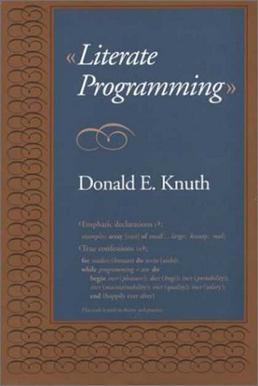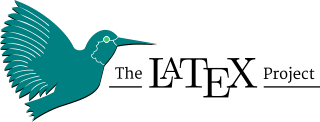
Literate programming is a programming paradigm introduced in 1984 by Donald Knuth in which a computer program is given as an explanation of how it works in a natural language, such as English, interspersed (embedded) with snippets of macros and traditional source code, from which compilable source code can be generated. The approach is used in scientific computing and in data science routinely for reproducible research and open access purposes. Literate programming tools are used by millions of programmers today.

LaTeX is a software system for document preparation. When writing, the writer uses plain text as opposed to the formatted text found in WYSIWYG word processors like Microsoft Word, LibreOffice Writer and Apple Pages. The writer uses markup tagging conventions to define the general structure of a document, to stylise text throughout a document, and to add citations and cross-references. A TeX distribution such as TeX Live or MiKTeX is used to produce an output file suitable for printing or digital distribution.
TeX, stylized within the system as TeX, is a typesetting system which was designed and written by computer scientist and Stanford University professor Donald Knuth and first released in 1978. TeX is a popular means of typesetting complex mathematical formulae; it has been noted as one of the most sophisticated digital typographical systems.
Web is a computer programming system created by Donald E. Knuth as the first implementation of what he called "literate programming": the idea that one could create software as works of literature, by embedding source code inside descriptive text, rather than the reverse, in an order that is convenient for exposition to human readers, rather than in the order demanded by the compiler.

BibTeX is reference management software for formatting lists of references. The BibTeX tool is typically used together with the LaTeX document preparation system. Within the typesetting system, its name is styled as . The name is a portmanteau of the word bibliography and the name of the TeX typesetting software.

Texinfo is a typesetting syntax used for generating documentation in both on-line and printed form with a single source file. It is implemented by a computer program released as free software of the same name, created and made available by the GNU Project from the Free Software Foundation.

Doxygen is a documentation generator and static analysis tool for software source trees. When used as a documentation generator, Doxygen extracts information from specially-formatted comments within the code. When used for analysis, Doxygen uses its parse tree to generate diagrams and charts of the code structure. Doxygen can cross reference documentation and code, so that the reader of a document can easily refer to the actual code.

ConTeXt is a general-purpose document processor. Like LaTeX, it is derived from TeX. It is especially suited for structured documents, automated document production, very fine typography, and multi-lingual typesetting. It is based in part on the TeX typesetting system, and uses a document markup language for manuscript preparation. The typographical and automated capabilities of ConTeXt are extensive, including interfaces for handling microtypography, multiple footnotes and footnote classes, and manipulating OpenType fonts and features. Moreover, it offers extensive support for colors, backgrounds, hyperlinks, presentations, figure-text integration, and conditional compilation. It gives the user extensive control over formatting while making it easy to create new layouts and styles without learning the low-level TeX macro language.
ArabTeX is a free software package providing support for the Arabic and Hebrew alphabets to TeX and LaTeX. Written by Klaus Lagally, it can take romanized ASCII or native script input to produce quality ligatures for Arabic, Persian, Urdu, Pashto, Sindhi, Western Punjabi (Lahnda), Maghribi, Uyghur, Kashmiri, Hebrew, Judeo-Arabic, Ladino and Yiddish. ArabTeX characters are placed within a TeX/LaTeX document using the command \RL{ ... } or the environment \begin{RLtext} ... \end{RLtext}. ArabTeX is released under the LaTeX Project Public License v1+.
The following tables compare general and technical information for a number of documentation generators. Please see the individual products' articles for further information. Unless otherwise specified in footnotes, comparisons are based on the stable versions without any add-ons, extensions or external programs. Note that many of the generators listed are no longer maintained.

teTeX was a TeX distribution for Unix-like systems. As of May 2006, teTeX is no longer actively maintained and its former maintainer Thomas Esser recommended TeX Live as the replacement.
AsciiDoc is a human-readable document format, semantically equivalent to DocBook XML, but using plain-text mark-up conventions. AsciiDoc documents can be created using any text editor and read “as-is”, or rendered to HTML or any other format supported by a DocBook tool-chain, i.e. PDF, TeX, Unix manpages, e-books, slide presentations, etc. Common file extensions for AsciiDoc files are txt and adoc.

TeX Live is a cross-platform, free software distribution for the TeX typesetting system that includes major TeX-related programs, macro packages, and fonts. It is the replacement of its no-longer supported counterpart teTeX. It is now the default TeX distribution for several Linux distributions such as openSUSE, Fedora, Debian, Ubuntu, Termux and Gentoo. Other Unix operating systems like OpenBSD, FreeBSD and NetBSD have also converted from teTeX to TeX Live.

SymPy is an open-source Python library for symbolic computation. It provides computer algebra capabilities either as a standalone application, as a library to other applications, or live on the web as SymPy Live or SymPy Gamma. SymPy is simple to install and to inspect because it is written entirely in Python with few dependencies. This ease of access combined with a simple and extensible code base in a well known language make SymPy a computer algebra system with a relatively low barrier to entry.
LuaTeX is a TeX-based computer typesetting system which started as a version of pdfTeX with a Lua scripting engine embedded. After some experiments it was adopted by the TeX Live distribution as a successor to pdfTeX. Later in the project some functionality of Aleph was included. The project was originally sponsored by the Oriental TeX project, founded by Idris Samawi Hamid, Hans Hagen, and Taco Hoekwater.
The computer program pdfTeX is an extension of Knuth's typesetting program TeX, and was originally written and developed into a publicly usable product by Hàn Thế Thành as a part of the work for his PhD thesis at the Faculty of Informatics, Masaryk University, Brno, Czech Republic. The idea of making this extension to TeX was conceived during the early 1990s, when Jiří Zlatuška and Phil Taylor discussed some developmental ideas with Donald Knuth at Stanford University. Knuth later met Hàn Thế Thành in Brno during his visit to the Faculty of Informatics to receive an honorary doctorate from Masaryk University.
The following is a comparison of TeX editors.

KBibTeX is a reference management software primarily for BibTeX which is typically used in conjunction with TeX/LaTeX. Beyond normal editing capabilities, KBibTeX offers features such as searching and importing new references from Google Scholar or BibSonomy.









